Climate Change, Health Issues, and Nursing Strategies: A Report
VerifiedAdded on 2022/08/13
|7
|1796
|12
Report
AI Summary
This report examines the health implications of climate change, specifically focusing on the rise of vector-borne diseases like Zika virus and increased respiratory problems. The study compares health concerns in the United States with those in developing and developed countries, highlighting the role of environmental factors and temperature variability. It emphasizes the importance of nurses in implementing health promotion strategies to address these issues, including raising awareness, advocating for change, and participating in mitigation efforts. The report underscores the need for proactive measures, such as training programs for nurses, to effectively combat the health challenges posed by climate change. The report concludes that climate change is exacerbating health issues and that nurses are key drivers of change in this context. The report references various studies and data to support its findings.
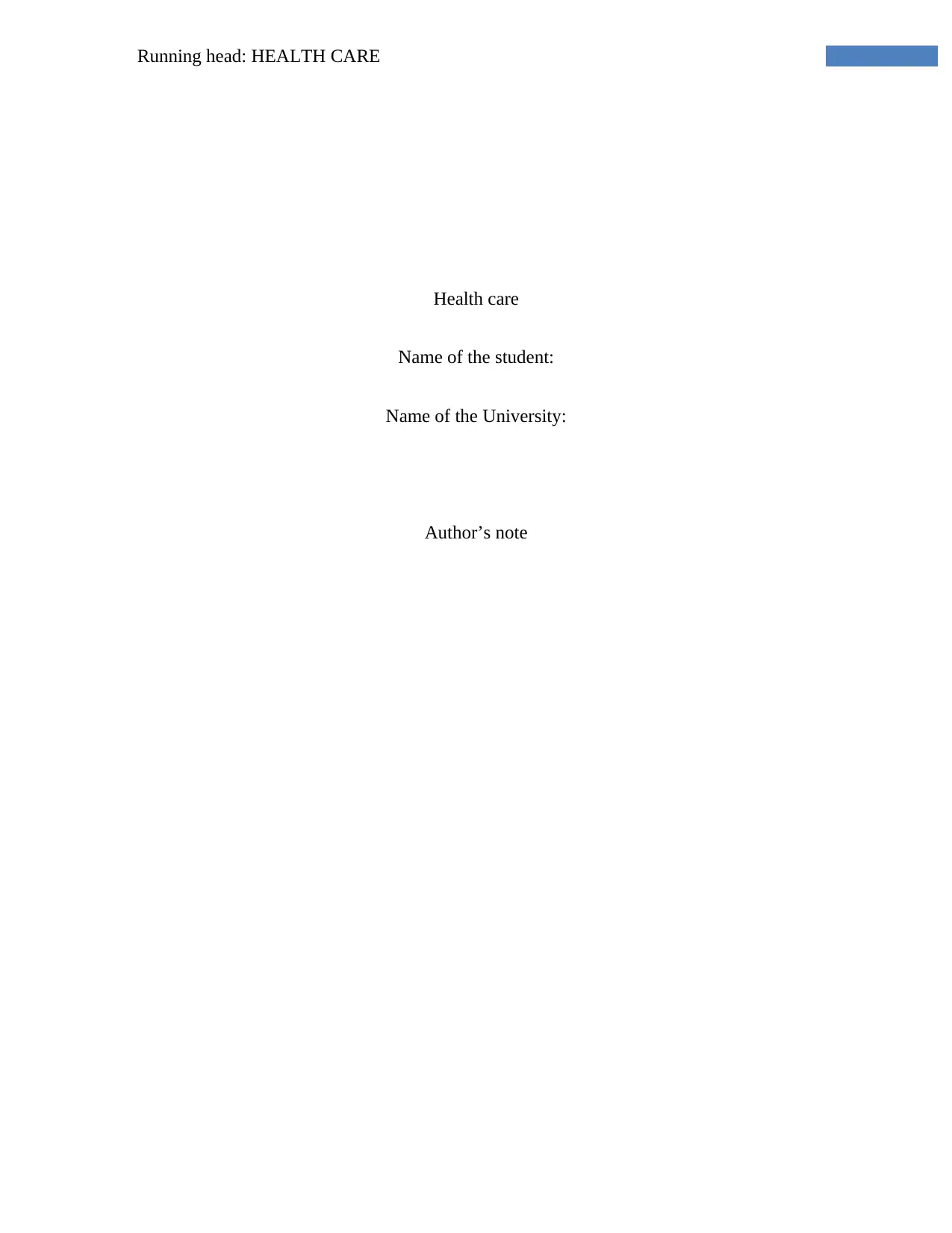
Running head: HEALTH CARE
Health care
Name of the student:
Name of the University:
Author’s note
Health care
Name of the student:
Name of the University:
Author’s note
Paraphrase This Document
Need a fresh take? Get an instant paraphrase of this document with our AI Paraphraser
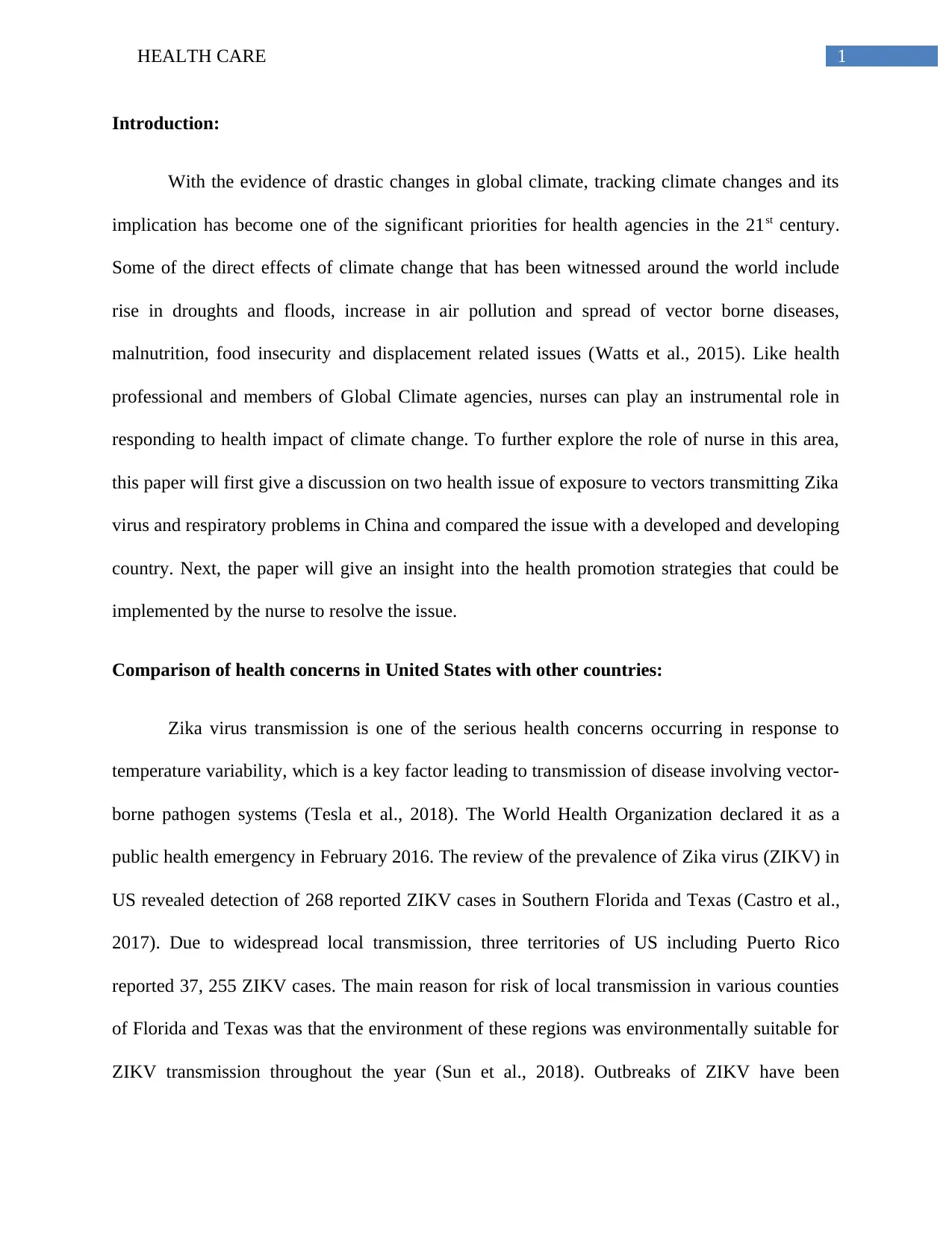
1HEALTH CARE
Introduction:
With the evidence of drastic changes in global climate, tracking climate changes and its
implication has become one of the significant priorities for health agencies in the 21st century.
Some of the direct effects of climate change that has been witnessed around the world include
rise in droughts and floods, increase in air pollution and spread of vector borne diseases,
malnutrition, food insecurity and displacement related issues (Watts et al., 2015). Like health
professional and members of Global Climate agencies, nurses can play an instrumental role in
responding to health impact of climate change. To further explore the role of nurse in this area,
this paper will first give a discussion on two health issue of exposure to vectors transmitting Zika
virus and respiratory problems in China and compared the issue with a developed and developing
country. Next, the paper will give an insight into the health promotion strategies that could be
implemented by the nurse to resolve the issue.
Comparison of health concerns in United States with other countries:
Zika virus transmission is one of the serious health concerns occurring in response to
temperature variability, which is a key factor leading to transmission of disease involving vector-
borne pathogen systems (Tesla et al., 2018). The World Health Organization declared it as a
public health emergency in February 2016. The review of the prevalence of Zika virus (ZIKV) in
US revealed detection of 268 reported ZIKV cases in Southern Florida and Texas (Castro et al.,
2017). Due to widespread local transmission, three territories of US including Puerto Rico
reported 37, 255 ZIKV cases. The main reason for risk of local transmission in various counties
of Florida and Texas was that the environment of these regions was environmentally suitable for
ZIKV transmission throughout the year (Sun et al., 2018). Outbreaks of ZIKV have been
Introduction:
With the evidence of drastic changes in global climate, tracking climate changes and its
implication has become one of the significant priorities for health agencies in the 21st century.
Some of the direct effects of climate change that has been witnessed around the world include
rise in droughts and floods, increase in air pollution and spread of vector borne diseases,
malnutrition, food insecurity and displacement related issues (Watts et al., 2015). Like health
professional and members of Global Climate agencies, nurses can play an instrumental role in
responding to health impact of climate change. To further explore the role of nurse in this area,
this paper will first give a discussion on two health issue of exposure to vectors transmitting Zika
virus and respiratory problems in China and compared the issue with a developed and developing
country. Next, the paper will give an insight into the health promotion strategies that could be
implemented by the nurse to resolve the issue.
Comparison of health concerns in United States with other countries:
Zika virus transmission is one of the serious health concerns occurring in response to
temperature variability, which is a key factor leading to transmission of disease involving vector-
borne pathogen systems (Tesla et al., 2018). The World Health Organization declared it as a
public health emergency in February 2016. The review of the prevalence of Zika virus (ZIKV) in
US revealed detection of 268 reported ZIKV cases in Southern Florida and Texas (Castro et al.,
2017). Due to widespread local transmission, three territories of US including Puerto Rico
reported 37, 255 ZIKV cases. The main reason for risk of local transmission in various counties
of Florida and Texas was that the environment of these regions was environmentally suitable for
ZIKV transmission throughout the year (Sun et al., 2018). Outbreaks of ZIKV have been
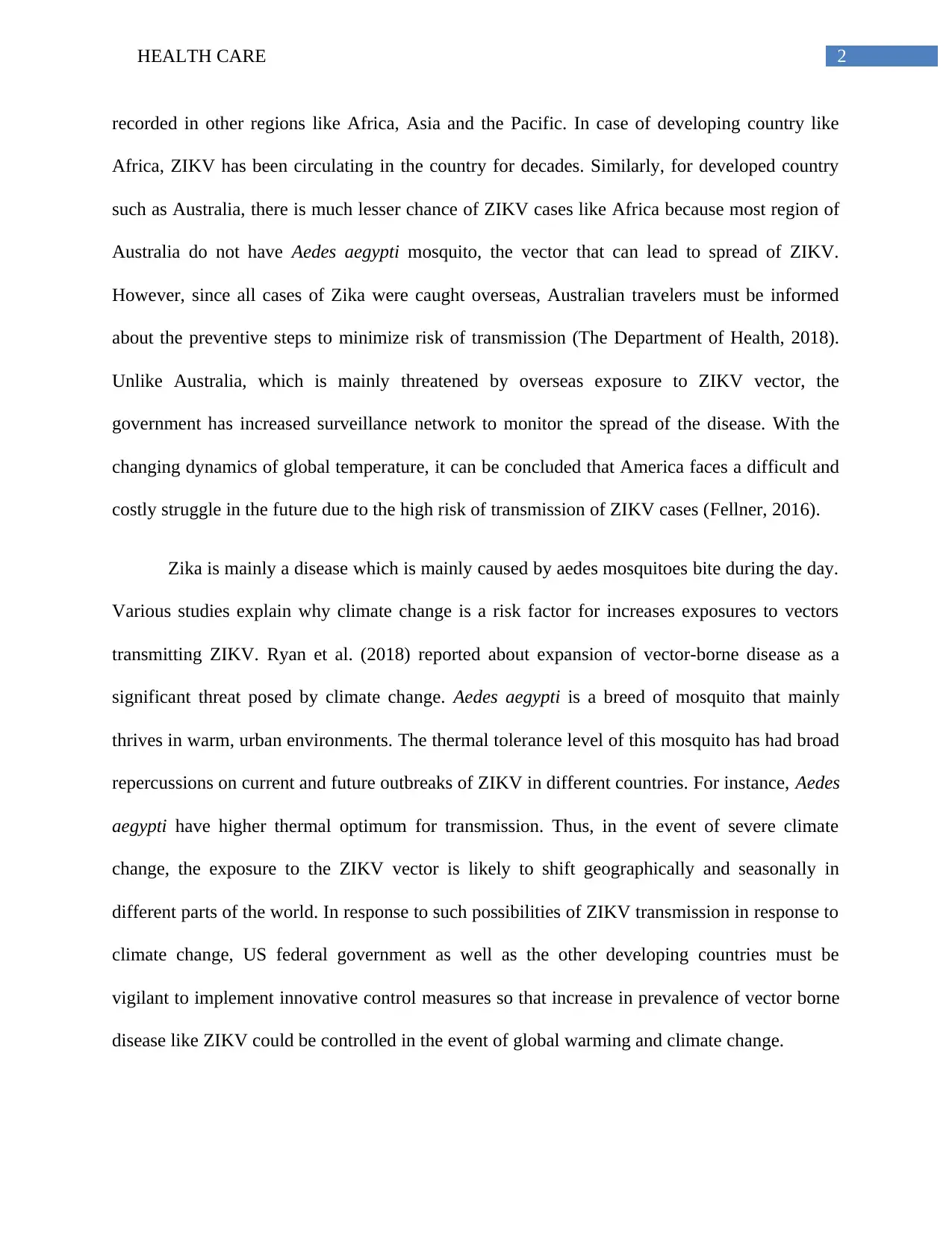
2HEALTH CARE
recorded in other regions like Africa, Asia and the Pacific. In case of developing country like
Africa, ZIKV has been circulating in the country for decades. Similarly, for developed country
such as Australia, there is much lesser chance of ZIKV cases like Africa because most region of
Australia do not have Aedes aegypti mosquito, the vector that can lead to spread of ZIKV.
However, since all cases of Zika were caught overseas, Australian travelers must be informed
about the preventive steps to minimize risk of transmission (The Department of Health, 2018).
Unlike Australia, which is mainly threatened by overseas exposure to ZIKV vector, the
government has increased surveillance network to monitor the spread of the disease. With the
changing dynamics of global temperature, it can be concluded that America faces a difficult and
costly struggle in the future due to the high risk of transmission of ZIKV cases (Fellner, 2016).
Zika is mainly a disease which is mainly caused by aedes mosquitoes bite during the day.
Various studies explain why climate change is a risk factor for increases exposures to vectors
transmitting ZIKV. Ryan et al. (2018) reported about expansion of vector-borne disease as a
significant threat posed by climate change. Aedes aegypti is a breed of mosquito that mainly
thrives in warm, urban environments. The thermal tolerance level of this mosquito has had broad
repercussions on current and future outbreaks of ZIKV in different countries. For instance, Aedes
aegypti have higher thermal optimum for transmission. Thus, in the event of severe climate
change, the exposure to the ZIKV vector is likely to shift geographically and seasonally in
different parts of the world. In response to such possibilities of ZIKV transmission in response to
climate change, US federal government as well as the other developing countries must be
vigilant to implement innovative control measures so that increase in prevalence of vector borne
disease like ZIKV could be controlled in the event of global warming and climate change.
recorded in other regions like Africa, Asia and the Pacific. In case of developing country like
Africa, ZIKV has been circulating in the country for decades. Similarly, for developed country
such as Australia, there is much lesser chance of ZIKV cases like Africa because most region of
Australia do not have Aedes aegypti mosquito, the vector that can lead to spread of ZIKV.
However, since all cases of Zika were caught overseas, Australian travelers must be informed
about the preventive steps to minimize risk of transmission (The Department of Health, 2018).
Unlike Australia, which is mainly threatened by overseas exposure to ZIKV vector, the
government has increased surveillance network to monitor the spread of the disease. With the
changing dynamics of global temperature, it can be concluded that America faces a difficult and
costly struggle in the future due to the high risk of transmission of ZIKV cases (Fellner, 2016).
Zika is mainly a disease which is mainly caused by aedes mosquitoes bite during the day.
Various studies explain why climate change is a risk factor for increases exposures to vectors
transmitting ZIKV. Ryan et al. (2018) reported about expansion of vector-borne disease as a
significant threat posed by climate change. Aedes aegypti is a breed of mosquito that mainly
thrives in warm, urban environments. The thermal tolerance level of this mosquito has had broad
repercussions on current and future outbreaks of ZIKV in different countries. For instance, Aedes
aegypti have higher thermal optimum for transmission. Thus, in the event of severe climate
change, the exposure to the ZIKV vector is likely to shift geographically and seasonally in
different parts of the world. In response to such possibilities of ZIKV transmission in response to
climate change, US federal government as well as the other developing countries must be
vigilant to implement innovative control measures so that increase in prevalence of vector borne
disease like ZIKV could be controlled in the event of global warming and climate change.
⊘ This is a preview!⊘
Do you want full access?
Subscribe today to unlock all pages.

Trusted by 1+ million students worldwide
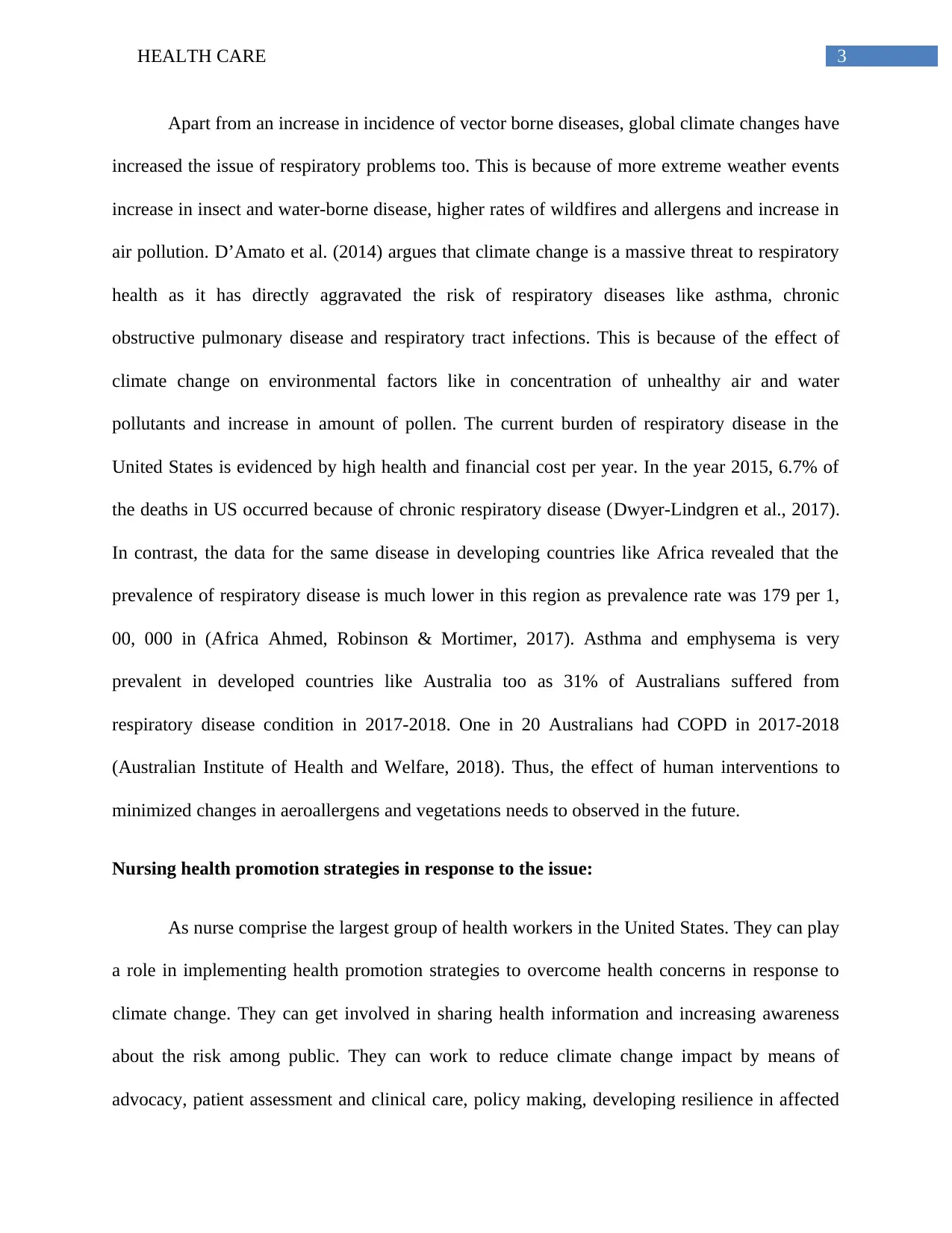
3HEALTH CARE
Apart from an increase in incidence of vector borne diseases, global climate changes have
increased the issue of respiratory problems too. This is because of more extreme weather events
increase in insect and water-borne disease, higher rates of wildfires and allergens and increase in
air pollution. D’Amato et al. (2014) argues that climate change is a massive threat to respiratory
health as it has directly aggravated the risk of respiratory diseases like asthma, chronic
obstructive pulmonary disease and respiratory tract infections. This is because of the effect of
climate change on environmental factors like in concentration of unhealthy air and water
pollutants and increase in amount of pollen. The current burden of respiratory disease in the
United States is evidenced by high health and financial cost per year. In the year 2015, 6.7% of
the deaths in US occurred because of chronic respiratory disease (Dwyer-Lindgren et al., 2017).
In contrast, the data for the same disease in developing countries like Africa revealed that the
prevalence of respiratory disease is much lower in this region as prevalence rate was 179 per 1,
00, 000 in (Africa Ahmed, Robinson & Mortimer, 2017). Asthma and emphysema is very
prevalent in developed countries like Australia too as 31% of Australians suffered from
respiratory disease condition in 2017-2018. One in 20 Australians had COPD in 2017-2018
(Australian Institute of Health and Welfare, 2018). Thus, the effect of human interventions to
minimized changes in aeroallergens and vegetations needs to observed in the future.
Nursing health promotion strategies in response to the issue:
As nurse comprise the largest group of health workers in the United States. They can play
a role in implementing health promotion strategies to overcome health concerns in response to
climate change. They can get involved in sharing health information and increasing awareness
about the risk among public. They can work to reduce climate change impact by means of
advocacy, patient assessment and clinical care, policy making, developing resilience in affected
Apart from an increase in incidence of vector borne diseases, global climate changes have
increased the issue of respiratory problems too. This is because of more extreme weather events
increase in insect and water-borne disease, higher rates of wildfires and allergens and increase in
air pollution. D’Amato et al. (2014) argues that climate change is a massive threat to respiratory
health as it has directly aggravated the risk of respiratory diseases like asthma, chronic
obstructive pulmonary disease and respiratory tract infections. This is because of the effect of
climate change on environmental factors like in concentration of unhealthy air and water
pollutants and increase in amount of pollen. The current burden of respiratory disease in the
United States is evidenced by high health and financial cost per year. In the year 2015, 6.7% of
the deaths in US occurred because of chronic respiratory disease (Dwyer-Lindgren et al., 2017).
In contrast, the data for the same disease in developing countries like Africa revealed that the
prevalence of respiratory disease is much lower in this region as prevalence rate was 179 per 1,
00, 000 in (Africa Ahmed, Robinson & Mortimer, 2017). Asthma and emphysema is very
prevalent in developed countries like Australia too as 31% of Australians suffered from
respiratory disease condition in 2017-2018. One in 20 Australians had COPD in 2017-2018
(Australian Institute of Health and Welfare, 2018). Thus, the effect of human interventions to
minimized changes in aeroallergens and vegetations needs to observed in the future.
Nursing health promotion strategies in response to the issue:
As nurse comprise the largest group of health workers in the United States. They can play
a role in implementing health promotion strategies to overcome health concerns in response to
climate change. They can get involved in sharing health information and increasing awareness
about the risk among public. They can work to reduce climate change impact by means of
advocacy, patient assessment and clinical care, policy making, developing resilience in affected
Paraphrase This Document
Need a fresh take? Get an instant paraphrase of this document with our AI Paraphraser
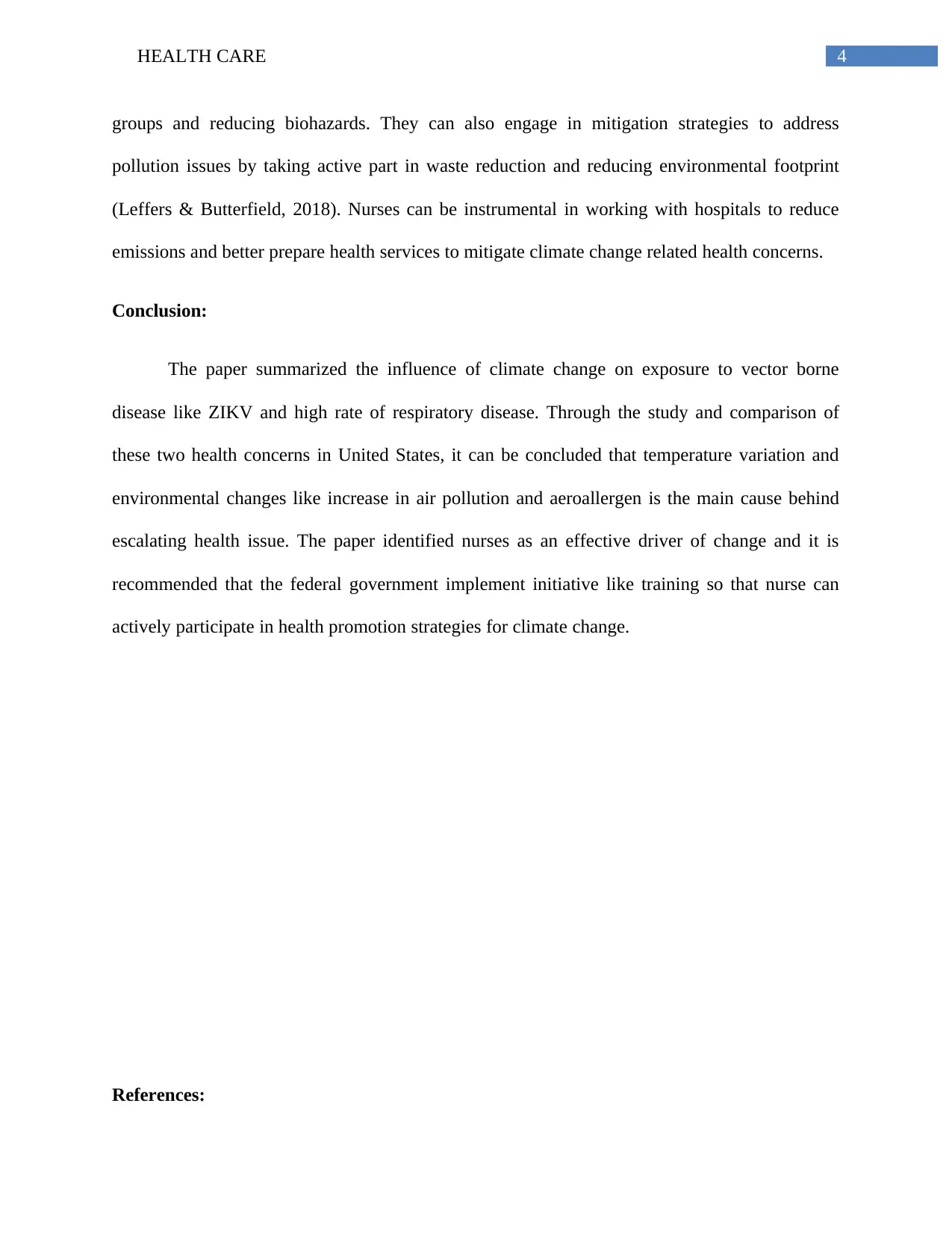
4HEALTH CARE
groups and reducing biohazards. They can also engage in mitigation strategies to address
pollution issues by taking active part in waste reduction and reducing environmental footprint
(Leffers & Butterfield, 2018). Nurses can be instrumental in working with hospitals to reduce
emissions and better prepare health services to mitigate climate change related health concerns.
Conclusion:
The paper summarized the influence of climate change on exposure to vector borne
disease like ZIKV and high rate of respiratory disease. Through the study and comparison of
these two health concerns in United States, it can be concluded that temperature variation and
environmental changes like increase in air pollution and aeroallergen is the main cause behind
escalating health issue. The paper identified nurses as an effective driver of change and it is
recommended that the federal government implement initiative like training so that nurse can
actively participate in health promotion strategies for climate change.
References:
groups and reducing biohazards. They can also engage in mitigation strategies to address
pollution issues by taking active part in waste reduction and reducing environmental footprint
(Leffers & Butterfield, 2018). Nurses can be instrumental in working with hospitals to reduce
emissions and better prepare health services to mitigate climate change related health concerns.
Conclusion:
The paper summarized the influence of climate change on exposure to vector borne
disease like ZIKV and high rate of respiratory disease. Through the study and comparison of
these two health concerns in United States, it can be concluded that temperature variation and
environmental changes like increase in air pollution and aeroallergen is the main cause behind
escalating health issue. The paper identified nurses as an effective driver of change and it is
recommended that the federal government implement initiative like training so that nurse can
actively participate in health promotion strategies for climate change.
References:
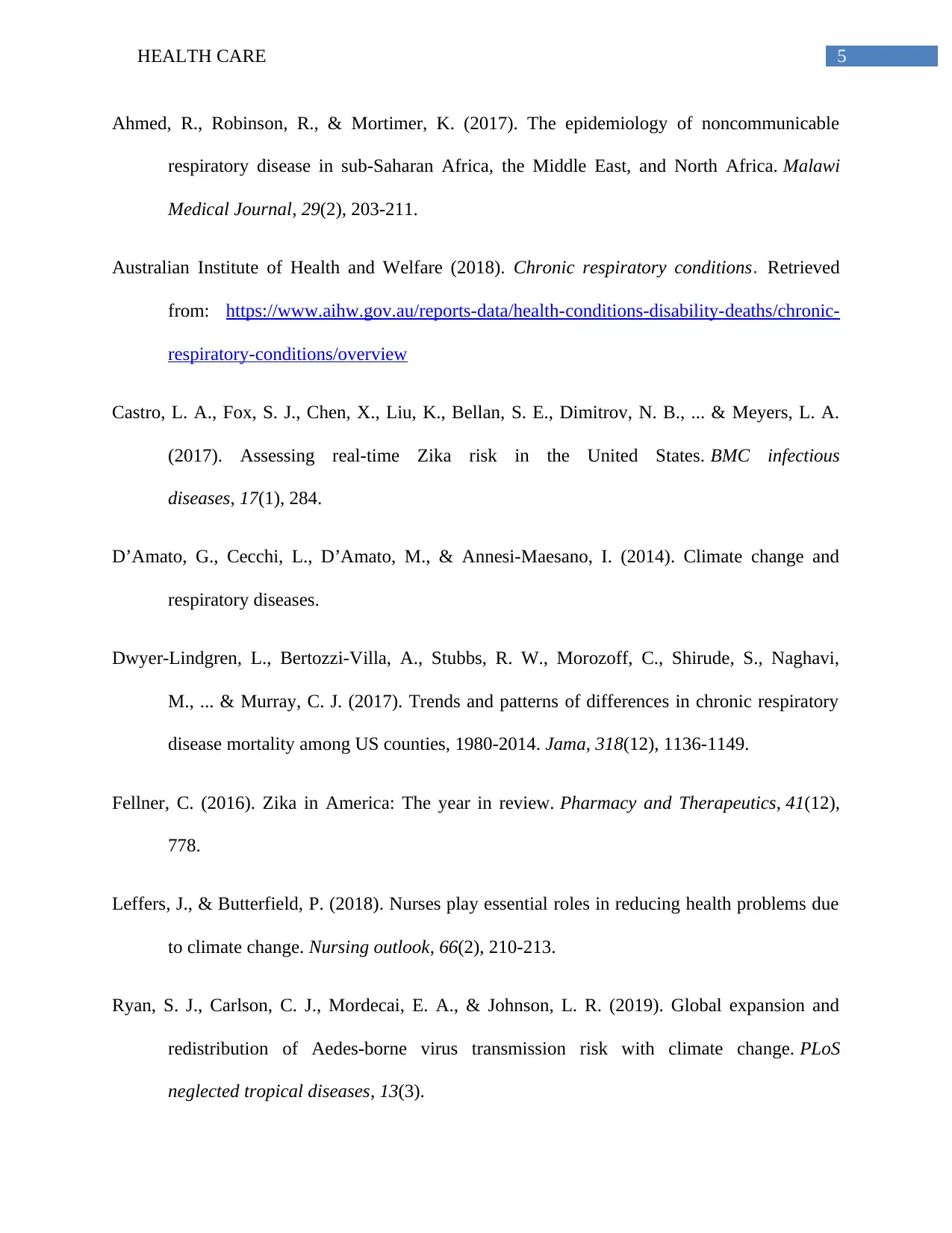
5HEALTH CARE
Ahmed, R., Robinson, R., & Mortimer, K. (2017). The epidemiology of noncommunicable
respiratory disease in sub-Saharan Africa, the Middle East, and North Africa. Malawi
Medical Journal, 29(2), 203-211.
Australian Institute of Health and Welfare (2018). Chronic respiratory conditions. Retrieved
from: https://www.aihw.gov.au/reports-data/health-conditions-disability-deaths/chronic-
respiratory-conditions/overview
Castro, L. A., Fox, S. J., Chen, X., Liu, K., Bellan, S. E., Dimitrov, N. B., ... & Meyers, L. A.
(2017). Assessing real-time Zika risk in the United States. BMC infectious
diseases, 17(1), 284.
D’Amato, G., Cecchi, L., D’Amato, M., & Annesi-Maesano, I. (2014). Climate change and
respiratory diseases.
Dwyer-Lindgren, L., Bertozzi-Villa, A., Stubbs, R. W., Morozoff, C., Shirude, S., Naghavi,
M., ... & Murray, C. J. (2017). Trends and patterns of differences in chronic respiratory
disease mortality among US counties, 1980-2014. Jama, 318(12), 1136-1149.
Fellner, C. (2016). Zika in America: The year in review. Pharmacy and Therapeutics, 41(12),
778.
Leffers, J., & Butterfield, P. (2018). Nurses play essential roles in reducing health problems due
to climate change. Nursing outlook, 66(2), 210-213.
Ryan, S. J., Carlson, C. J., Mordecai, E. A., & Johnson, L. R. (2019). Global expansion and
redistribution of Aedes-borne virus transmission risk with climate change. PLoS
neglected tropical diseases, 13(3).
Ahmed, R., Robinson, R., & Mortimer, K. (2017). The epidemiology of noncommunicable
respiratory disease in sub-Saharan Africa, the Middle East, and North Africa. Malawi
Medical Journal, 29(2), 203-211.
Australian Institute of Health and Welfare (2018). Chronic respiratory conditions. Retrieved
from: https://www.aihw.gov.au/reports-data/health-conditions-disability-deaths/chronic-
respiratory-conditions/overview
Castro, L. A., Fox, S. J., Chen, X., Liu, K., Bellan, S. E., Dimitrov, N. B., ... & Meyers, L. A.
(2017). Assessing real-time Zika risk in the United States. BMC infectious
diseases, 17(1), 284.
D’Amato, G., Cecchi, L., D’Amato, M., & Annesi-Maesano, I. (2014). Climate change and
respiratory diseases.
Dwyer-Lindgren, L., Bertozzi-Villa, A., Stubbs, R. W., Morozoff, C., Shirude, S., Naghavi,
M., ... & Murray, C. J. (2017). Trends and patterns of differences in chronic respiratory
disease mortality among US counties, 1980-2014. Jama, 318(12), 1136-1149.
Fellner, C. (2016). Zika in America: The year in review. Pharmacy and Therapeutics, 41(12),
778.
Leffers, J., & Butterfield, P. (2018). Nurses play essential roles in reducing health problems due
to climate change. Nursing outlook, 66(2), 210-213.
Ryan, S. J., Carlson, C. J., Mordecai, E. A., & Johnson, L. R. (2019). Global expansion and
redistribution of Aedes-borne virus transmission risk with climate change. PLoS
neglected tropical diseases, 13(3).
⊘ This is a preview!⊘
Do you want full access?
Subscribe today to unlock all pages.

Trusted by 1+ million students worldwide
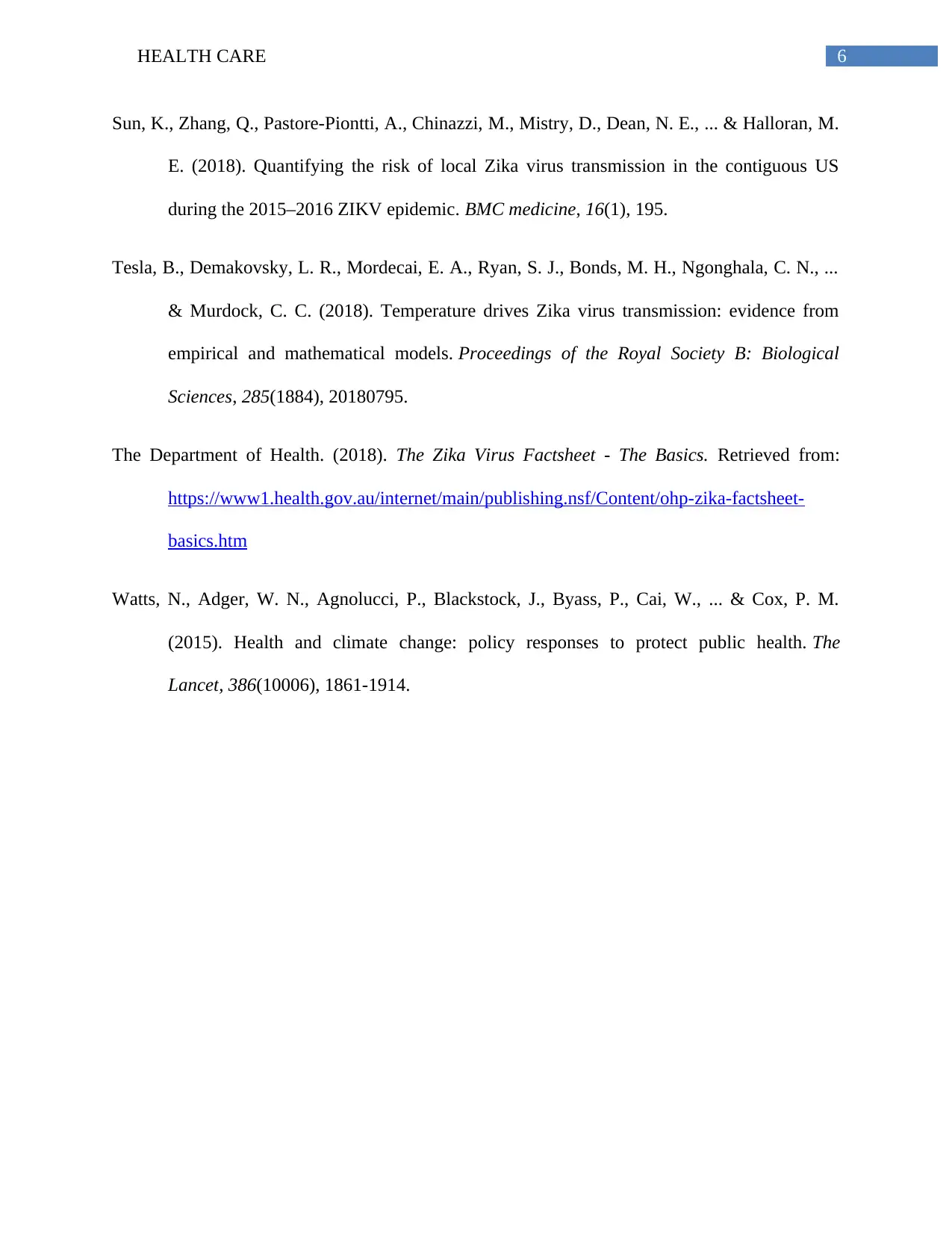
6HEALTH CARE
Sun, K., Zhang, Q., Pastore-Piontti, A., Chinazzi, M., Mistry, D., Dean, N. E., ... & Halloran, M.
E. (2018). Quantifying the risk of local Zika virus transmission in the contiguous US
during the 2015–2016 ZIKV epidemic. BMC medicine, 16(1), 195.
Tesla, B., Demakovsky, L. R., Mordecai, E. A., Ryan, S. J., Bonds, M. H., Ngonghala, C. N., ...
& Murdock, C. C. (2018). Temperature drives Zika virus transmission: evidence from
empirical and mathematical models. Proceedings of the Royal Society B: Biological
Sciences, 285(1884), 20180795.
The Department of Health. (2018). The Zika Virus Factsheet - The Basics. Retrieved from:
https://www1.health.gov.au/internet/main/publishing.nsf/Content/ohp-zika-factsheet-
basics.htm
Watts, N., Adger, W. N., Agnolucci, P., Blackstock, J., Byass, P., Cai, W., ... & Cox, P. M.
(2015). Health and climate change: policy responses to protect public health. The
Lancet, 386(10006), 1861-1914.
Sun, K., Zhang, Q., Pastore-Piontti, A., Chinazzi, M., Mistry, D., Dean, N. E., ... & Halloran, M.
E. (2018). Quantifying the risk of local Zika virus transmission in the contiguous US
during the 2015–2016 ZIKV epidemic. BMC medicine, 16(1), 195.
Tesla, B., Demakovsky, L. R., Mordecai, E. A., Ryan, S. J., Bonds, M. H., Ngonghala, C. N., ...
& Murdock, C. C. (2018). Temperature drives Zika virus transmission: evidence from
empirical and mathematical models. Proceedings of the Royal Society B: Biological
Sciences, 285(1884), 20180795.
The Department of Health. (2018). The Zika Virus Factsheet - The Basics. Retrieved from:
https://www1.health.gov.au/internet/main/publishing.nsf/Content/ohp-zika-factsheet-
basics.htm
Watts, N., Adger, W. N., Agnolucci, P., Blackstock, J., Byass, P., Cai, W., ... & Cox, P. M.
(2015). Health and climate change: policy responses to protect public health. The
Lancet, 386(10006), 1861-1914.
1 out of 7
Related Documents
Your All-in-One AI-Powered Toolkit for Academic Success.
+13062052269
info@desklib.com
Available 24*7 on WhatsApp / Email
![[object Object]](/_next/static/media/star-bottom.7253800d.svg)
Unlock your academic potential
Copyright © 2020–2025 A2Z Services. All Rights Reserved. Developed and managed by ZUCOL.





